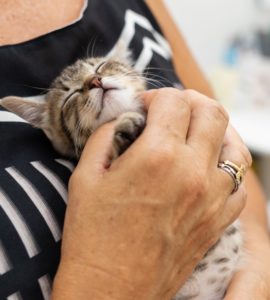Lifestyle and Living
Advice for Pet Parents, New and Old – Part 1
Feb 2022 | By Catherine Daley
Helpful advice for new pet owners, as well as long-term, house-broken animal lovers – Part 1
In conversation with Donna Curtin DVM, Practice Owner and Veterinarian, Hanover Veterinary Hospital, whvc.ca
The answers below suggest general guidelines, only. It is always recommended to consult with your veterinarian, because like people, each animal has their own unique personality and health requirements.
What type of pet would you recommend for a more mature pet owner?
 Many senior pet owners enjoy smaller dogs and cats. If a large dog gets ill, it can be difficult and dangerous to move them, while a sick cat can easily be transitioned to a veterinary facility in a carrier. Overall, the choice of the ideal pet is very personal and with preparation and planning, many older clients enjoy all sorts of different pets.
Many senior pet owners enjoy smaller dogs and cats. If a large dog gets ill, it can be difficult and dangerous to move them, while a sick cat can easily be transitioned to a veterinary facility in a carrier. Overall, the choice of the ideal pet is very personal and with preparation and planning, many older clients enjoy all sorts of different pets.
What shots should a new puppy or kitten have?
The initial requirements for vaccination may change from region to region, however, most new puppies will need their first Distemper, Parvo, and Parainfluenza vaccination around eight weeks of age, while kittens should get their initial Herpes, Calicivirus, and Panleukopenia vaccination at eight weeks.
At what age can you get a pet fixed?
The general guideline has always been six months.
For dogs, there are a couple shifts to this recommendation. We recommend spaying or neutering small breeds when the adult teeth have come in. This is because some little dogs are notorious for not losing their baby teeth correctly, so we can then help with the baby teeth at the same time as their spay or neuter procedure.
Alternately, in larger breed dogs, there are some studies to suggest that there are possible health benefits to waiting until they are 12 to 14 months of age, like the potential reduction in orthopedic condition, including hip dysplasia. These benefits would need to be weighed against the increased risks of breast cancer for females who are spayed at a later age, or aggression concerns in some intact male dogs.
With regard to cats, is declawing still a common practice? 
Declawing cats is no longer common practice in Ontario, and many veterinary practices no longer offer this service. There is no medical benefit to the surgical removal of a cat’s toes, and studies have shown that we are doing harm, as this procedure can leave cats in untreated pain and discomfort.
Can you advise as to how much, and how often, a certain breed, size or stature of pet should be fed?
Unfortunately, there isn’t a one size fits all response. For example, a new puppy usually adopted around eight weeks of age, will need frequent, smaller meals of a higher energy diet. Puppies also need properly balanced mineral contents for growth and development.
On the flip side, many senior cats benefit from a more reserved protein level to protect kidney function and for a less-active lifestyle. Both will benefit from healthy levels of essential fatty acids to encourage brain development and learning in the puppy, and to help retain cognitive function in the senior cat.
There are calculations to determine energy requirements depending on the age and weight of a pet. Your veterinary team can help to advise the amount of pet food, depending upon the calories per cup of the chosen diet.
Raw food is very popular these days. Your comment?
 Raw foods do seem to be on the rise in popularity. In consultation with boarded veterinary nutritionists, their best advice has always been to provide a balanced meal that is nutritionally available. Raw foods are not as digestible, and the nutrients more difficult, or unavailable, for your pet’s needs. Cooked diets make the nutrients easier for your pet to digest and to absorb.
Raw foods do seem to be on the rise in popularity. In consultation with boarded veterinary nutritionists, their best advice has always been to provide a balanced meal that is nutritionally available. Raw foods are not as digestible, and the nutrients more difficult, or unavailable, for your pet’s needs. Cooked diets make the nutrients easier for your pet to digest and to absorb.
Also, depending on the brand and reputation of the diet, not all commercially available raw foods have been properly balanced. Finally, there is a risk with feeding raw, due to the potential for increased ingestion of bacteria like Salmonella. Studies have shown that pets who eat raw diets can contaminate the home with Salmonella, which could be a risk to young children or immunocompromised individuals.
The choice to feed raw should be made with full knowledge of potential risks, and in discussion with your veterinarian.
There are so many choices when it comes to food. Wet or dry? Or a combination of both?
The choice to feed a wet diet, or a cooked kibble diet is a personal choice. The best diet is nutritionally balanced, suits the individual pet’s needs, is reputable, affordable and a diet that your pet enjoys. As a veterinarian, it is nice if a pet, especially cats, get the occasional canned-food meal, because we then have the option of offering canned if needed to treat various health conditions.
An interesting fact is that most pet owners believe that by feeding a kibble diet they are helping to keep their pet’s teeth clean. However, studies show there is no difference to the cleanliness of a pet’s teeth – both diets accumulate plaque and tartar the same. To help keep the teeth clean, you need to feed them a specially formulated diet that has been proven to prevent plaque and tartar accumulation.

